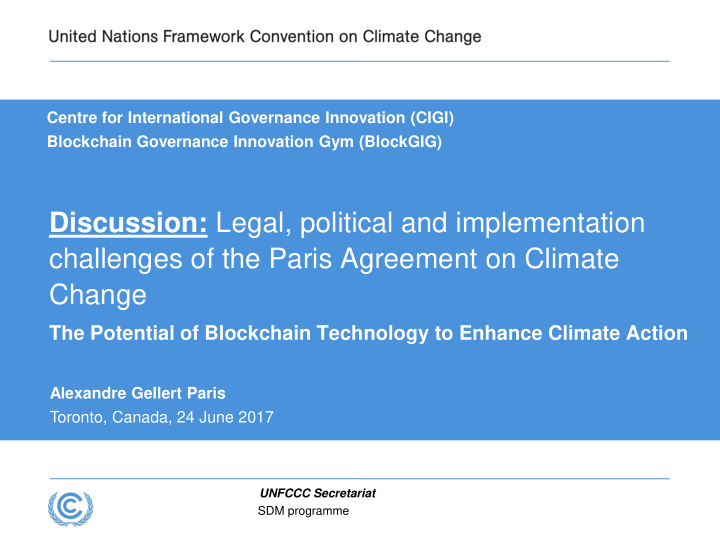



Centre for International Governance Innovation (CIGI) Blockchain Governance Innovation Gym (BlockGIG) Discussion: Legal, political and implementation challenges of the Paris Agreement on Climate Change The Potential of Blockchain Technology to Enhance Climate Action Alexandre Gellert Paris Toronto, Canada, 24 June 2017 UNFCCC Secretariat SDM programme
2
The UNFCCC Secretariat In 1992, countries adopted the United Nations Framework Convention on Climate Change (UNFCCC) as a response to the problem of global warming. Five years later, they adopted the Kyoto Protocol, which strengthens the Convention by setting legally binding emission reduction requirements for 37 industrialized countries. The ultimate objective of both treaties is to stabilize greenhouse gas concentrations in the atmosphere at a level that will prevent dangerous human interference with the climate system. In 1996, Governments decided to accept the offer of the German Government to locate the secretariat in the German city of Bonn. At the head of the secretariat is the Executive Secretary. This position is currently held by Patricia Espinosa Cantellano.
UNFCCC Secretariat – Facts andFigures Hosts and administers a dozen Annual expenditures of official registries, databases and aprox. USD 115million systems related to adaptation, mitigation and finance Strong social media Supports up-to 30.000 presence: 270K follower participants attending annual @UNFCCC, 155K likes on Conferences of Parties (COP) Facebook Coordinates the workof 15 constituted bodies and 500 staff from 80 countries expert groups C To date has assessed,processed Coordinates and supports on and certified approximately average 375side events and exhibits atCOPs 2 billion CDM Certified Emmission Reductions. Organizes 80 conferences, Prepares around 450 workshops and meetings on UN documents and legal texts average per year a year
The UNFCCC Secretariat The UNFCCC secretariat is a UN agency whose mission is to support cooperative action by States and non-State actors to combat climate change and its impact on humanity and ecosystems. This is a contribution to a sustainable world and to realizing the vision of peace, security and human dignity on which the UN is founded.
UNFCCC Secretariat – The future post Paris Objective of the Convention Challenges Maximizing impact: Operationalizing the Responding to Managing a Paris Agreement: budgetary realities: top performing Partnering with organization: governments, the UN, civil society Supporting a com Delivering a and the private plex regime growing number Maintaining an sector for of tasks with agile, innovative increased climate limited core and attractive action resources institution
7
The Paris Agreement 8
The Paris Agreement 29 articles, 25 pages Parties aim to reach global peaking of greenhouse gas emissions as soon as possible , recognizing that peaking will take longer for developing country Parties, and to undertake rapid reductions thereafter in accordance with best available science, so as to achieve a balance between anthropogenic emissions by sources and removals by sinks of greenhouse gases in the second half of this century (Article 4) 9
Every Word Counts http://www.politico.eu/article/one-word-almost-sunk-climate-talks-legally-binding-cop21-deal-global-warming/ 10
You shall not pass …and the path to zero disagreement. 11
The Paris Agreement 12
The Paris Agreement Implementation of NDCs MRV Higher ambitions Collaborative actions
UNEP The Emissions Gap Report 2016 Annual Global Total Greenhouse Gas Emissions (GtCO 2e ) 14
The Paris Agreement Accelerating, encouraging and enabling innovation is critical for an effective, long-term global response to climate change and promoting economic growth and sustainable development Article 10, the Paris Agreement 15
The Blockchain Since the invention of double-entry bookkeeping in the seventh century, innovation in accounting was limited by the tedious process of reconciling ledgers But with the advent of blockchain’s distributed ledger system, the action of reconciling, along with many other processes categorized as "post-trade" can be rendered largely redundant Rob Nail, CEO of Singularity University 16
The Blockchain Blockchain technology is based on a distributed network, which allows for high-level trust among users and better monitoring over the stored data 17
Blockchain applications Moody's Investors Service (MIS) explored how blockchain tech potentially can improve record-keeping and transactional efficiencies across many different processes and industries Moody's found that many companies are assessing how blockchain technology could affect their businesses and identified over 120 ongoing projects among the issuers that it rates 18
Blockchain within the UN System UNOPS, UNDP, UNICEF, UN Women and UNHCR are all investigating the application of blockchain in different areas The ITU has created a new Focus Group to analyze the standardization demands of applications and services built on distributed ledger technologies such as blockchain. The WFP is the first UN agency to experiment with blockchain technology. The agency is using blockchain technology to distribute humanitarian aid to those in need. A pilot for cash-based transfers is ongoing in Jordan, where WFP authenticates 10K beneficiaries on the blockchain 19
The Blockchain Blockchain technology for climate action Potential applications: Improved carbon emission trading; Peer-to-peer renewable energy trading; Enhanced climate finance flows; Better tracking and reporting of GHG emissions reduction and avoidance of double counting; Supply chain management; Land titling; etc… 20
Intersection of Blockchain and Climate Change The UNFCCC secretariat recognizes potential of blockchain technology . Key aspects: Transparency; Cost-effectiveness; Efficiency; Stakeholder integration; and Enhanced creation of global public goods (commons) The secretariat supports initiatives that lead to innovation at the intersection of blockchain and climate change . 21
Intersection of Blockchain and Climate Change The secretariat will be: Convening (together with partners) key stakeholders to highlight their work related to blockchain technology in the margin of COP23 (side event + booth + hackathon) Enhancing the NAZCA = Non-State Actor Zone for Climate Action platform under the Marrakech Partnership for Global Climate Action Exploring blockchain applications to corporates under the Gold Standard Partnership 22
COP23
Recommend
More recommend